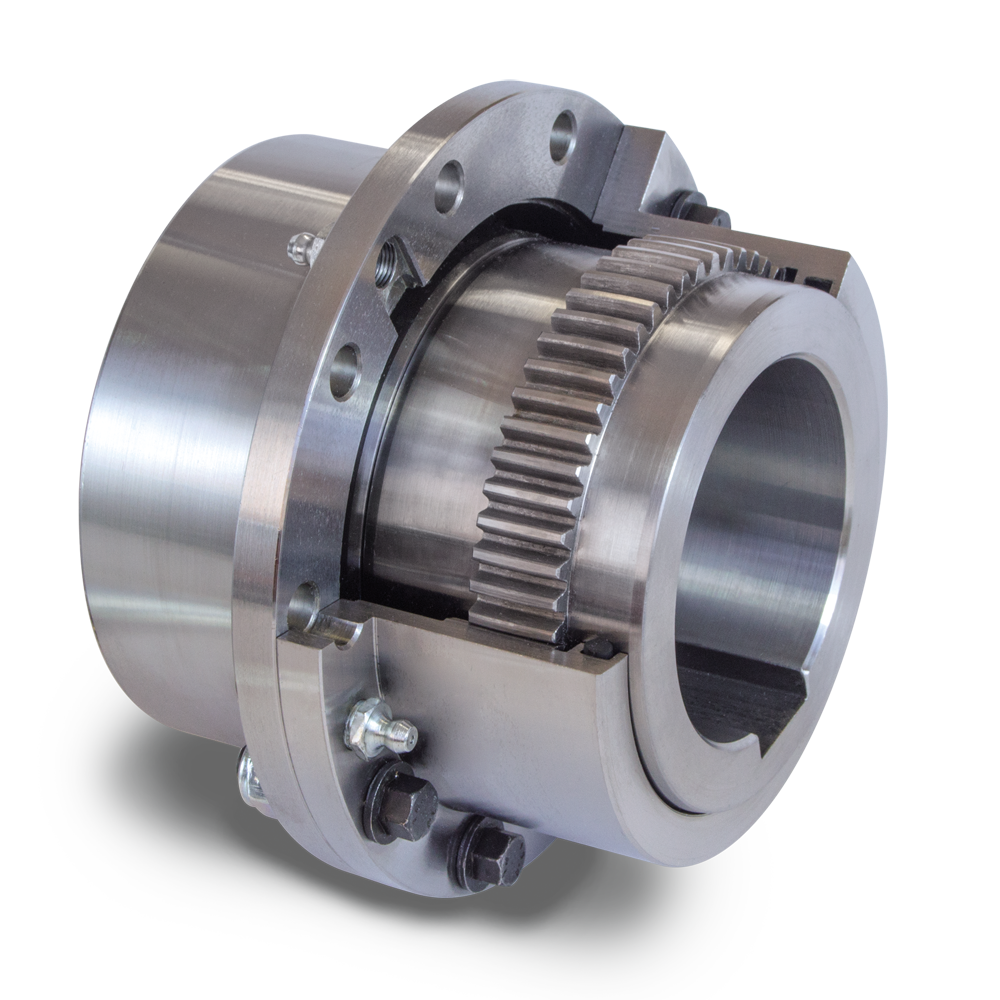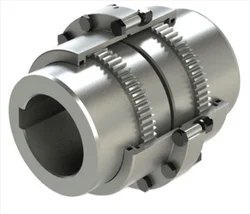Product Description
High-speed rail couplings
The Gear Transmission Division covers an area of more than 80,000 square meters. It has more than 350 sets of various equipment, including machining centers, turning centers, CNC lathes, precision grinding machines (CNC), CNC profile grinding machines, gear testing machines, three-coordinate testing machines, gearbox comprehensive performance test benches, well carburising furnaces, multi-purpose furnaces, nitriding furnaces, induction machines, quenching and pressing machines, etc. With a full range of equipment and a wide processing range, our company has ability to process and test internal and external gears with an external diameter of up to φ2500mm, a module of up to 45mm and an accuracy of up to AGMA 14-13 grade or DIN 3962 grade 3-4, forming an annual production capacity of nearly 60,000 gears and more than 15,000 sets of gearboxes. It has established a first-class domestic and world advanced gear transmission system industrialization base.
4400 Slave gear Mechanical drive gear HXD1C Traction gear
Detailed Photos
Company Profile
CHINAMFG Xihu (West Lake) Dis. Institute Co.,Ltd is a state-own company affiliated with CHINAMFG group. Found in 1959, it locates in HangZhou city in the great ZheJiang region.Focus on R&D of critical equipment for China railway industry, it is a specialized research institution for new material and processes for locomotive and rolling stocks, as well as a high-tech manufacturer of critical parts and components for railway transportation.Currently, it has about 3,000 employees working in 6 production sites, its revenue exceeded 700 million USD in 2571.
Rail transit equipment, automobiles and new energy vehicles, ships and marine engineering equipment, aerospace vehicles, energy-saving and environmental protection equipment, wind power generation equipment, mining machinery, robot parts, construction machinery, mechanical and electrical equipment, transmission devices, instrumentation, electronic appliances, plastics R&D, design, manufacture, sales, repair, leasing, and technical services of products, metal products and parts; Mold manufacturing, sales, repair, and technical services; Metal casting, forging, and welding; Surface treatment and heat treatment; Orbital welding Engineering construction; Product testing and testing; Professional technical and operational skills training (excluding vocational certificate training recognized by the state), technical and management consulting, conference services; Rental of self-owned houses and equipment; Self-operated and agency of various commodities and technology import and export business (except for goods and technologies that are restricted by the state or prohibited from import and export); Design and produce print advertisements, and use the company’s public publications to publish domestic advertisements.
Certifications
FAQ
1. How long is the product warranty period?
A: Two years.
2, how to place an order to our company?
A: After the products you need are confirmed by both parties, our company will CHINAMFG a contract with you, and we will execute the delivery and other related matters according to the contract terms.
3. How to distribute the product?
A: We generally provide FOB prices, and the freight is borne by the buyer. If the buyer has the demand, we can also provide CIF price, our company is responsible for shipping products.
4. Settlement currency?
A: We can settle in RMB, USD and Euro.
5. Return policy?
A: In case of any problem with the product, the 2 parties shall negotiate a return or exchange according to the terms and conditions of the contract.
6. After-sales problems?
A: If there is a quality problem during the warranty period, our company will answer it to the customer within 24 hours. If the problem is more serious, our company will arrive at the customer site within a week to answer it. Products beyond the warranty period we provide maintenance services, provide paid replacement parts, provide paid customer on-site service.
7, how to buy the fragile and consumable parts in the product?
A: Our company will make a list of vulnerable and consumable parts and provide channels for purchase.
/* January 22, 2571 19:08:37 */!function(){function s(e,r){var a,o={};try{e&&e.split(“,”).forEach(function(e,t){e&&(a=e.match(/(.*?):(.*)$/))&&1

Comparison of Tooth Couplings with Gear and Jaw Couplings
Tooth couplings, gear couplings, and jaw couplings are all types of couplings used in mechanical systems. Here’s a comparison of tooth couplings with gear and jaw couplings:
Tooth Couplings:
- They have interlocking teeth that provide high torque transmission capacity.
- Offer excellent misalignment compensation due to the tooth design.
- Can handle angular, radial, and axial misalignment.
- Transmit torque with low backlash and high torsional stiffness.
Gear Couplings:
- Use gears to transmit torque, providing high torque capacity.
- Handle angular misalignment but are less effective with radial and axial misalignment.
- Have backlash due to the gear design, which can affect precision applications.
- Require periodic lubrication and maintenance.
Jaw Couplings:
- Use elastomeric elements (jaws) for torque transmission.
- Provide good torsional stiffness and misalignment compensation.
- Handle moderate angular and axial misalignment but limited radial misalignment.
- Are simple in design and easy to install.
Ultimately, the choice between these couplings depends on the specific requirements of the application. Tooth couplings are preferred for high torque, precision, and demanding applications that require precise torque transmission and efficient misalignment compensation. Gear couplings excel in high torque situations but may have more backlash. Jaw couplings are suitable for simpler applications with moderate misalignment and torque requirements.

Best Practices for Lubricating and Preserving Tooth Coupling Performance
Proper lubrication is essential for preserving the performance and extending the lifespan of tooth couplings. Here are the best practices for lubricating tooth couplings:
- Choose the Right Lubricant: Select a lubricant that is compatible with the material of the coupling and its operating conditions. Consult manufacturer recommendations for suitable lubricants.
- Regular Lubrication: Establish a regular lubrication schedule based on the coupling’s usage and operating conditions. Over-lubrication can cause issues, so follow recommended intervals.
- Clean Before Lubrication: Clean the coupling’s teeth and surfaces before applying lubricant to prevent debris and contaminants from mixing with the lubricant.
- Use Appropriate Amount: Apply the appropriate amount of lubricant to ensure proper coverage of the teeth and other moving parts. Excessive lubrication can attract dirt and lead to other problems.
- Distribute Lubricant Evenly: Ensure that the lubricant is evenly distributed across the teeth and mating surfaces for consistent lubrication during operation.
- Monitor Performance: Regularly monitor the coupling’s performance, noise levels, and any unusual vibrations. Changes in performance may indicate inadequate lubrication or other issues.
- Inspect and Reapply: During maintenance intervals, inspect the coupling for signs of wear or inadequate lubrication. Reapply lubricant as needed to maintain optimal performance.
- Temperature Considerations: Consider the operating temperature of the system when selecting a lubricant. Extreme temperatures can affect the viscosity and effectiveness of the lubricant.
- Environment: If the coupling operates in a harsh environment, choose a lubricant that offers protection against contaminants, moisture, and corrosion.
- Follow Manufacturer Guidelines: Always follow the manufacturer’s recommendations for lubrication frequency, lubricant type, and application methods.
Proper lubrication contributes to reducing friction, wear, and the risk of overheating, ensuring the tooth coupling operates smoothly and efficiently over its service life.

Role of Tooth Couplings in Mechanical Systems
A tooth coupling is a type of mechanical coupling that connects two shafts to transmit torque while allowing for angular misalignment and axial movement between them. It consists of two hubs with external teeth that mesh together, engaging the teeth to transfer torque from one shaft to another. Tooth couplings are commonly used in various mechanical systems to provide a reliable and efficient means of transmitting power and motion.


editor by CX 2024-04-15
by
Tags:
Leave a Reply